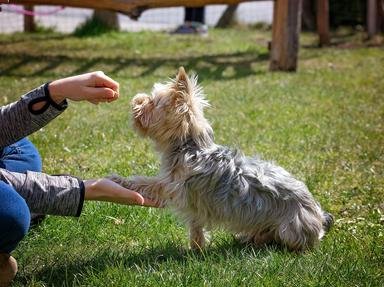Quiz Answer Key and Fun Facts
1. How is positive reinforcement often abbreviated?
2. What do the abbreviations p+ and p- stand for?(respectively)
3. In ___________, an adverse stimulus is taken away in order to increase a behavior.
4. Negative punishment involves employing an adverse stimulus.
5. Which of the following is an example of a non-operant technique?
6. _________ is a term used when a technique is used to end a behavior.
7. Which training technique involves enticing the dog to obey a command? Example: Moving a treat over the dog's head to get it to sit.
8. When you are "charging the clicker", what are you doing?
9. Flooding is a process to treat which of the following?
10. A dog owner is teaching his dog to sit down and stay instead of lunging at people passing by. What method is he using?
11. Your dog becomes panicked whenever he hears thunder and at times he is hard to control. Which training technique would be the best approach to this problem?
12. An owner is trying to teach his dog to dumbbell retrieve. The first thing he does is click when the dog looks at the dumbbell, then clicks when the dog touches it with his nose, later clicks if the dog takes the dumbbell in his mouth, lastly clicking when the dog picks it off the floor. What method is being employed here?
13. Physically moving, pushing, or grabbing the dog in order to get it to teach them what a command means is an example of what training technique?
14. Which of the following is an example of a classically conditioned response?
15. Bite inhibition in puppies is developed with their littermates. When a pup bites another pup too hard, the one that was bitten yelps and ignores the offending puppy. In theory bite inhibition is learned through what technique?
Source: Author
Jr_Dog_Expert
This quiz was reviewed by FunTrivia editor
crisw before going online.
Any errors found in FunTrivia content are routinely corrected through our feedback system.

